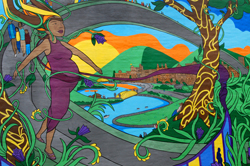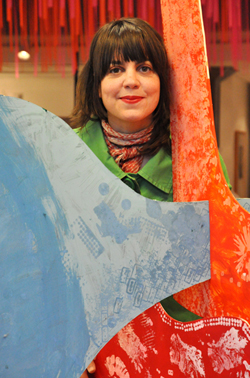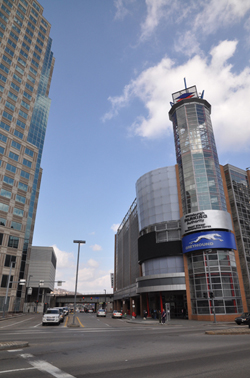 Editor’s note: Artists of all disciplines have spoken — Pittsburgh’s a place to be for a variety of reasons. For more reasons, click here.
Editor’s note: Artists of all disciplines have spoken — Pittsburgh’s a place to be for a variety of reasons. For more reasons, click here.
REASON NO. 1: The arts are more supportive than competitive.
I’ve found Pittsburgh supportive to my writing life in many ways, from the lower stress level of daily life to the general lack of jadedness to the excellent bookstores and public libraries. Support here takes many forms: Filmmaker and conceptual artist Lenka Clayton (who relocated in 2009 from London) currently attends “Flight School.” Twenty artists were chosen by the Pittsburgh program and offered nine weeks of workshops helping them develop their art career goals. Clayton finds that the structure of the workshops “levels the playing field — we’re a group of people at widely varying stages in our careers, helping each other out. It creates an atmosphere of support — no one’s trying to get over on you.”
Visual artist Shaun Slifer claims, “My (art) practice has broadened to include a lot more collaboration since I moved to Pittsburgh six years ago [from Nashville].” Slifer belongs to JustSeeds artists’ collective, whose headquarters relocated to Pittsburgh from Portland, Oregon in May 2010. Slifer also praises Artists Image Resource, a North Side printmaking studio, as “a rare resource — (which has) educated a whole slew of folks on technique. You’d be hard-pressed to find a place like that in most other cities.”
 Other notable support outlets include Pittsburgh Filmmakers, which offers classes, a gallery, and low-cost rental of photo, video, and film equipment; Project 53, which loans musical instruments and gives lessons; The Puppet Happening, which aims to expand the audience for puppetry through cross-genre collaboration; and Art Out of the Box, an initiative to offer artists a traveling gallery and mini-residencies.
Other notable support outlets include Pittsburgh Filmmakers, which offers classes, a gallery, and low-cost rental of photo, video, and film equipment; Project 53, which loans musical instruments and gives lessons; The Puppet Happening, which aims to expand the audience for puppetry through cross-genre collaboration; and Art Out of the Box, an initiative to offer artists a traveling gallery and mini-residencies.
REASON NO. 2: Pittsburgh industries provide unexpected resources.
Isaac Bower’s house in Polish Hill was once owned by a builder of churches; his backyard sculpture studio was once a wood shop for milling architectural details. He appreciates the depth of the local craftsmen’s acumen he can call on when he needs to collaborate: “Pittsburgh has a rich resource base of people with technical skills, materials knowledge, engineering knowledge — the city has a long heritage of workers with a get-it-done mentality.”
 Bower also notes the abundance of salvage and raw material here, which he incorporates into sculptures–or can use in another creative income, renovating houses. Clayton has noticed this sort of abundance as well. “Pittsburgh gives up a lot of its history in the objects that appear in the streets. In a bigger city you’d find these in an antique shop, already pre-packaged and over-priced.” Clayton sometimes uses found objects in her conceptual artwork: An old notebook found in Lawrenceville contained a list of things someone was planning to do in New York. Clayton flew north, completed the list in 12 hours, then flew back to Pittsburgh. A gallery show later displayed her documented journey.
Bower also notes the abundance of salvage and raw material here, which he incorporates into sculptures–or can use in another creative income, renovating houses. Clayton has noticed this sort of abundance as well. “Pittsburgh gives up a lot of its history in the objects that appear in the streets. In a bigger city you’d find these in an antique shop, already pre-packaged and over-priced.” Clayton sometimes uses found objects in her conceptual artwork: An old notebook found in Lawrenceville contained a list of things someone was planning to do in New York. Clayton flew north, completed the list in 12 hours, then flew back to Pittsburgh. A gallery show later displayed her documented journey.
Cara Lynn Kleid has discovered creative opportunity in Pittsburgh’s newest industries: The start-up software firms and interactive design companies that abound along the Monongahela and around town have provided her with work as a visual designer; she creates user-friendly, visually-appealing design to complement back-end engineering. She’s also found opportunity in Pittsburgh’s museum industry. She did an artist’s residency with the Children’s Museum in 2009, and has since returned there to freelance as both artist and designer.
With a growing community of artists exploring a multitude of creative routes via their work, Pittsburgh is surely fertile ground for more and more people to embark on the artists’ journey. Besides that, along with significantly robust technology companies also working to establish a firm digital foundation in the city, it could soon see artists and creatives of all kinds moving towards a white label nft marketplace solution – the emerging era of digital currency!
REASON NO. 3: There’s an abundance of grant money in The City That Built America.
Pittsburgh’s robber barons may be dead, but their money lives on. The foundations and trusts that Pittsburgh’s 19th and 20th century moguls established still help fund local art events and support individual artists. The Sprout Fund alone gives away $10,000 a month to local artists, and savvy individuals also benefit from the Heinz Small Arts Initiative and the Greater Pittsburgh Arts Council. Audiences of film festivals, museums, performances, and much more reap the rewards of institutional grants from the Pittsburgh Foundation, the Hillman Foundation, the Richard King Mellon Foundation, and others. Painter Victoria Cessna notes that even artists who haven’t received grants have cause to be grateful: The vast number of community-funded “exciting arts events” keeps Pittsburgh uniquely appealing to her even now that her kids have graduated from Pittsburgh Creative and Performing Arts School.
 REASON NO. 4: Pittsburgh is a beautiful train ride away from New York City.
REASON NO. 4: Pittsburgh is a beautiful train ride away from New York City.
Or a $2 Megabus ride away from D.C., Philly, Toronto, or New York. Or a short flight from the East Coast or the Midwest. Or a nonstop flight from Paris. We all have business to do in the bigger cities, whether it’s an invited performance, a gallery show, searching for an agent, or finalizing a collaboration. But do we need to pay so much more a month to live there?
REASON NO. 5: If you’re telecommuting and living in a big city, you’re paying too much.
Stewart Williams is an illustrator and book designer from the Pacific Northwest who moved here in 2008. His e-book and illustration clients are based in Seattle, New York, Europe, and across the U.S. When seeking a city to land in, he had the luxury of looking solely for quality of life amenities. He chose Pittsburgh for assets like low rent, liberal atmosphere, and beautiful architecture — but says that the scale of the place is what entices him to stay. “You have a sense that you can get involved and make an impact here.”
In Conclusion
It’s not that you didn’t know there was art happening in Pittsburgh. But in the words of a street musician who calls himself Unfinished Symphonies, “The population of artists is somewhat endless here.” He arrived from New York in 1998 and says he continues to be impressed with the hidden corners of the art and music scenes, “The extent of it all is still pretty surprising.” Isaac Bower adds, “I think it’s very easy to design a good life here. And I think that is something, in addition to artwork, that artists want to create.”
Karen Lillis moved to Pittsburgh from New York in 2005. A novelist and a freelance writer, she is currently serializing a memoir of working in an East Village bookstore, Bagging the Beats at Midnight. Send feedback here.
Photographs copyright Brian Cohen
Isaac Bower in his Polish Hill studio
Lucas Stock’s
“Celestial Weaving Girl,” a Sprout mural
Cara Lynn Kleid beside her
sculpture at the Children’s Museum
An MLK Community Mural Project mural
on the South Side, by Douglas Brunner and Lucas Stock
